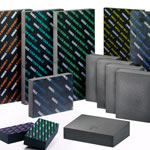Pittsburgh Corning Corporation has been innovating with glass for more than 75 years, building its business with glass blocks before adding Foamglas, a type of cellular glass insulation, to its production lines. Created from sand, limestone, and soda ash, Foamglas is free of CFCs, HFCs, and HCFCs, and the product’s lightweight, rigid material is marked with high compressive strength, non-combustibility, corrosion-resistance, dimensional stability, and moisture resistance.
Melting the raw materials and combining the resulting glass with a cellulating agent creates insulating blocks that can then be trimmed to be used as roof and wall insulation or fabricated into other shapes to fit around pipes. Other insulating materials, such as polyisocyanurate or polystyrene, have higher initial insulating value, but Foamglas has a longer useful life even if exposed to moisture.
Using Foamglas on a project will contribute to LEED credits, stemming from its uses in creating an energy-efficient building envelope and its lack of harmful gas emissions. It also works well with a vegetated roof because of its strength and moisture-resisting qualities. The manufacturing process of the cellular glass aims to be as green as possible; Pittsburgh Corning’s furnaces are fueled by natural gas and electricity. Also, waste heat is reused to preheat combustion air, and water is recirculated using minimal amounts of fresh water.

